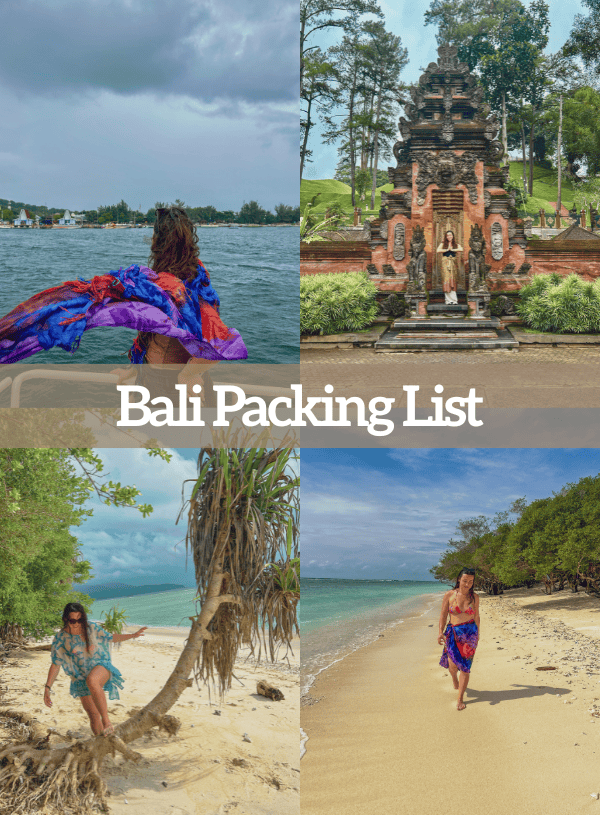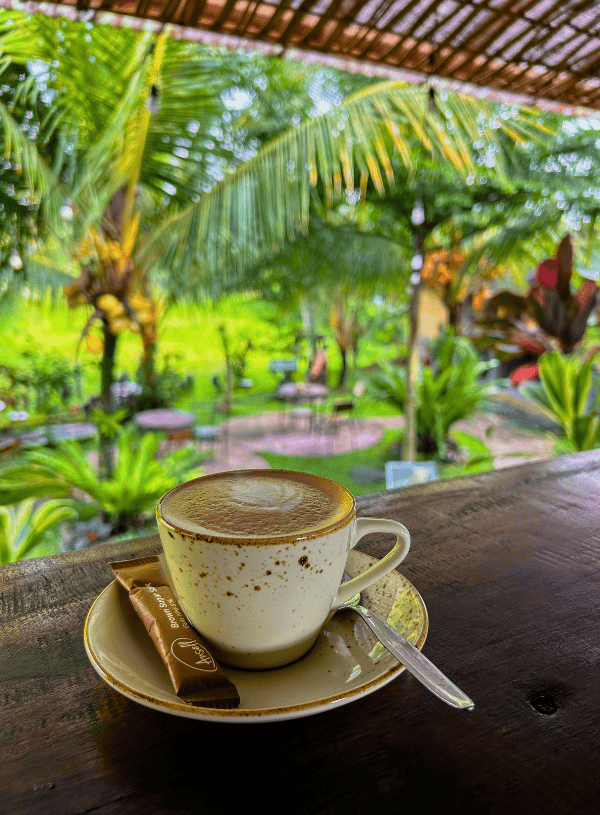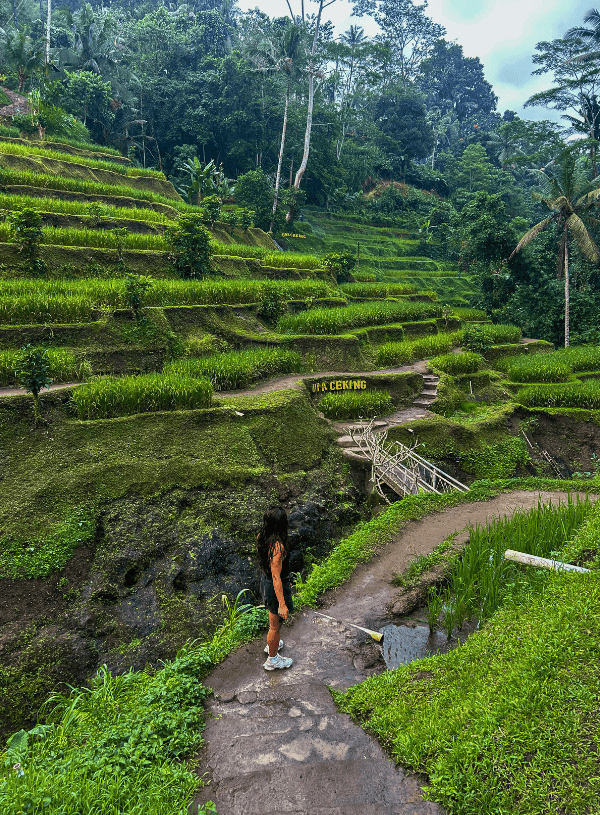Where To Stay in Ubud: 5 Best Areas, Hotels & Guest Houses
Last Updated on August 3, 2025
After living in Ubud for a while and personally going through the fun-but-overwhelming process of finding a place to live that felt peaceful—but not totally lost in the middle of the rice fields—I’ve created a mental map of the best areas to stay in Ubud, whether you’re visiting for a few days or planning to stay longer.
The truth is, Ubud has every type of vibe you can think of: busy and central, hippy and spiritual, quiet and surrounded by nature, village-style with local warungs, or trendy and full of expats and cute cafés. Honestly, the only thing missing here is the beach and nightclubs (but that’s what Canggu is for!).
So if you’re planning your short vacation or thinking of settling down here for a few months, keep reading—this guide will help you understand where to stay in Ubud, get a real feel for each area, and find the one that fits your version of Ubud best.
This article may contain affiliate links. This means that if you purchase through one of the links, I may be paid a small commission at no extra cost to you. Thank you for supporting the blog and allowing me to keep sharing meaningful travel experiences with you.
Don’t have time now?📌 Save it for later!
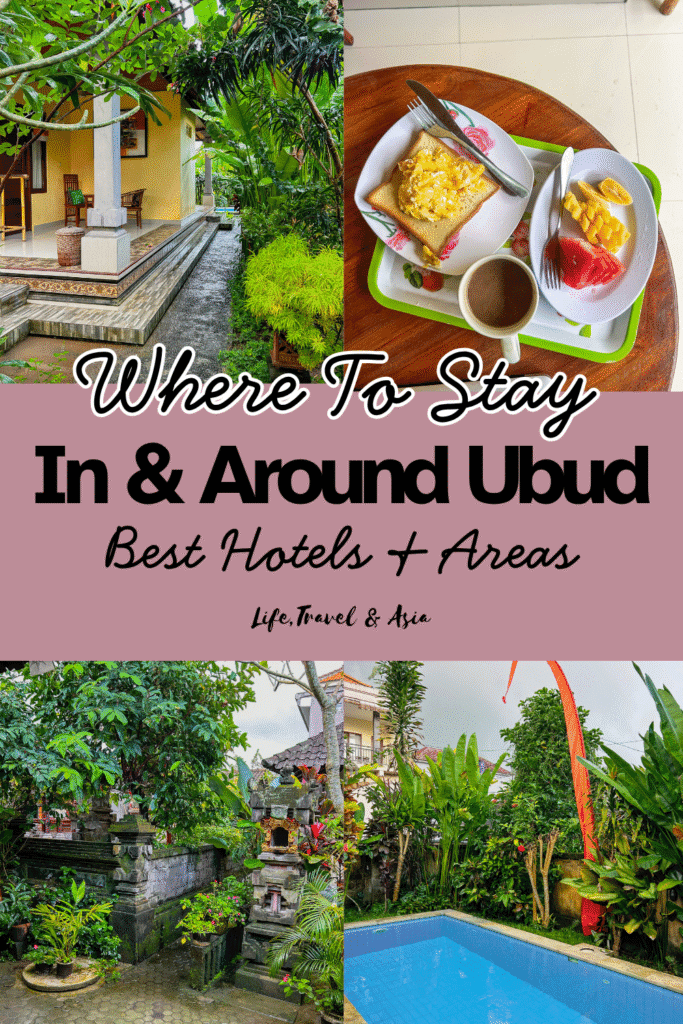
1. Ubud Center: Jl. Bisma & Jl. Sukma
Jl. Bisma and Jl. Sukma are the areas I know best in Ubud—meaning I know what it’s like to live there and what kind of vibe they offer.
They’re pretty similar: located on opposite sides of the main road (Jl. Raya), both are lively little streets with a great atmosphere, lots of restaurants and Warungs, and within walking distance of the very center, which I’d define as the Ubud Market area.
Jl. Sukma: Budget-Friendly Stays, Yoga Studios & Yummy Restaurants
Jl. Sukma is more budget-friendly, with plenty of guesthouses and homestays that are perfect for travelers looking to keep costs low.
It’s super close to The Yoga Barn and Radiantly Alive Yoga Studio, so if you’re planning a full-on yoga retreat, this location will make your life easier. If you’re planning to stay here, Jl. Jembawan and Jl Goutama are walking distance.
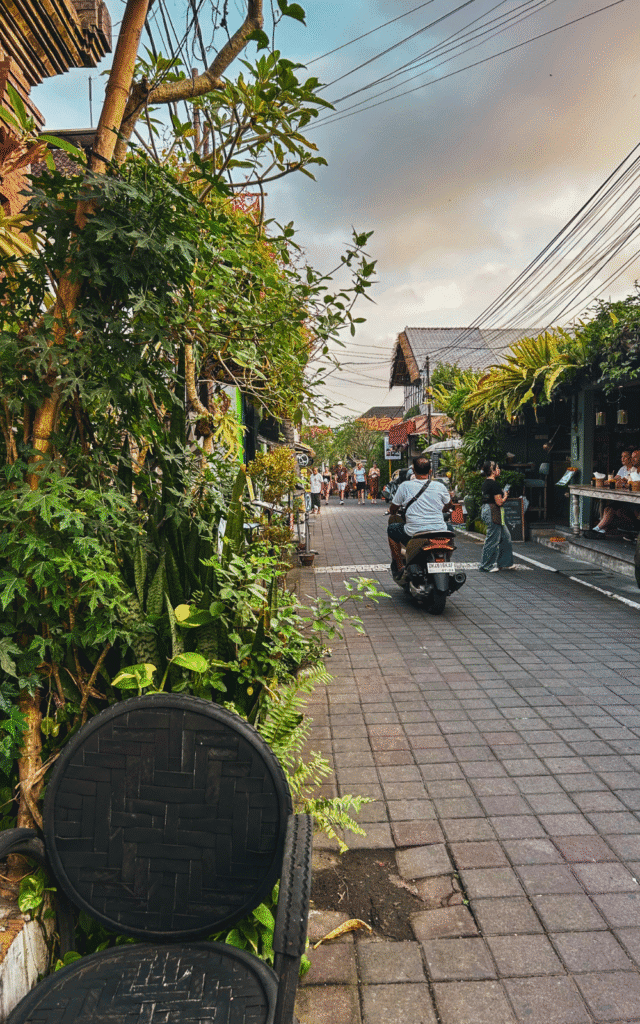
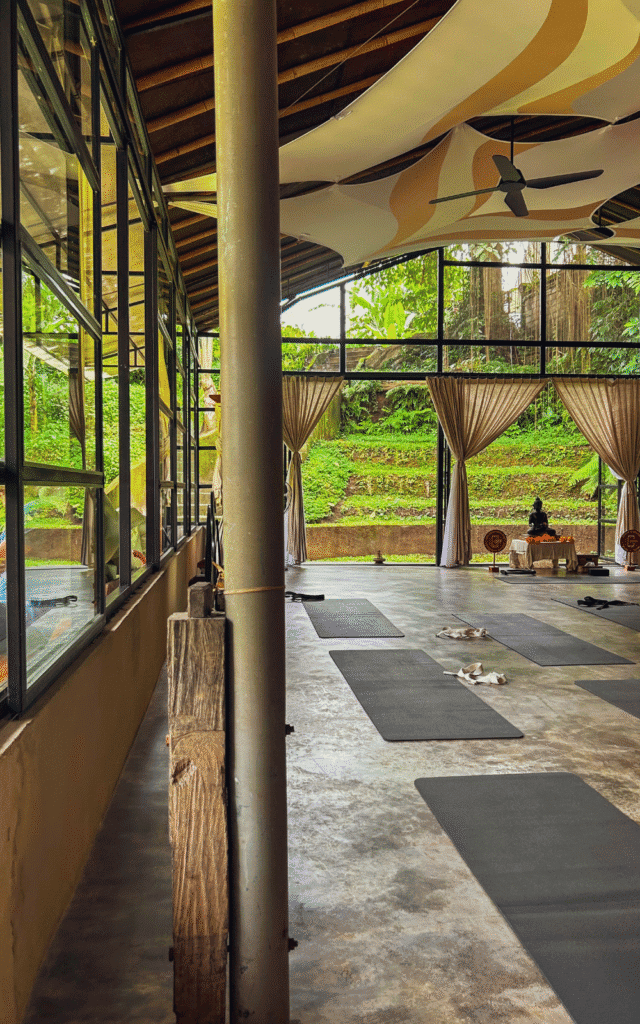
These are some of the best streets in central Ubud for local warungs — like Warung Nikuna or Sun Sun Warung, This is Bali, and Compound Warung, a favorite among travelers.
Here are a couple of suggestions if you’re planning on staying in Jl. Sukma: where to stay, where to eat, and things to do around.
1. Where to Stay
Low-Budget Option: Utu Homestay gives you the best of both worlds: a great location right at the start of Jl. Sukma, within walking distance of the main road and has an authentic Balinese atmosphere. The rooms are part of a traditional Balinese home compound, so you’ll see the family around and experience local life. Rooms are clean, spacious, and comfortable, especially considering the price.
Mid-Budget Option: Sens Hotel & Spa is located right at the entrance of Jl. Sukma, making it a great option if you want to stay close to the main road. The building itself is hard to miss, with its clean, modern look — and the rooms feel both cozy and stylish. The outdoor pool is a real highlight, and despite being so central, the hotel remains quiet and peaceful.
2. Favorite Restaurants on Jl Sukma
Sayuri Healing Food is more than just a restaurant — it’s a café, coworking space, academy, and honestly, a great spot for a nap too. It’s my favorite vegan place in Ubud, and I’d go way more often if it were just a bit closer to where I stay. If you’re after delicious plant-based meals, the classic Ubud hippie vibe, classes to join, and a creative atmosphere, you’ll find it all here.
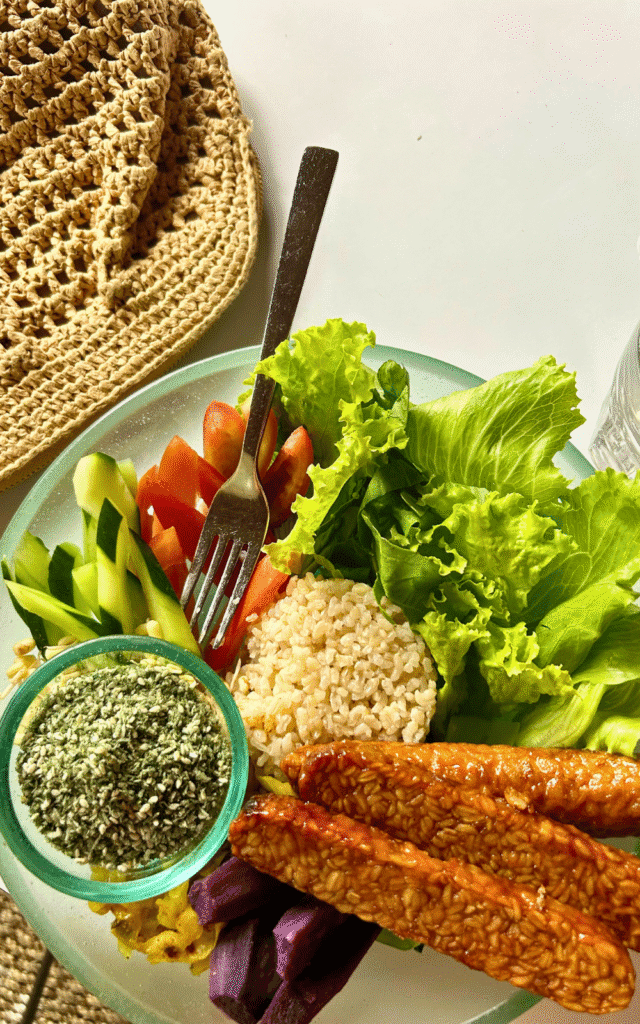
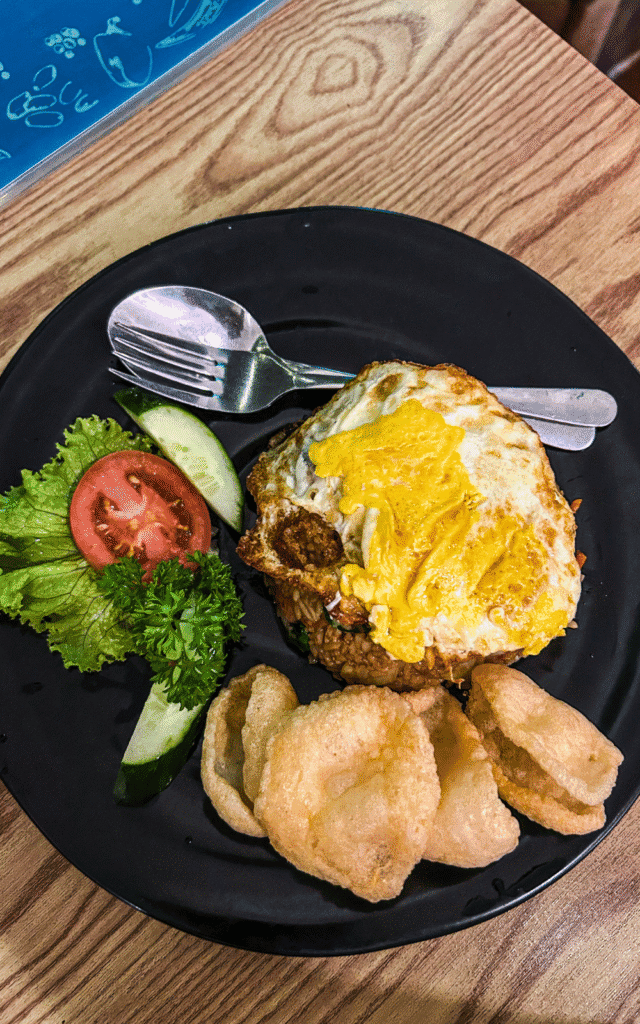
Mama’s Warung: During my first week here, I ended up coming back three nights in a row — the food was that good. The lovely Balinese ladies who run it are incredibly warm and welcoming, the food is genuinely fantastic, and the prices are super low. If you’re after home-cooked Balinese food, definitely check it out.
Jl. Bisma: Monkeys, Pubs & Padel
Jl. Bisma, on the other hand, has a wider range of options: you’ll find resorts, guesthouses, small residences, and stays surrounded by rice fields—there’s a lot to choose from.
If you’re planning to stay on Jl. Bisma, know that monkeys are pretty much permanent guests here.
But don’t worry — our monkeys are chill and mostly mind their own business (which usually means jumping on electric cables and looking for snacks).
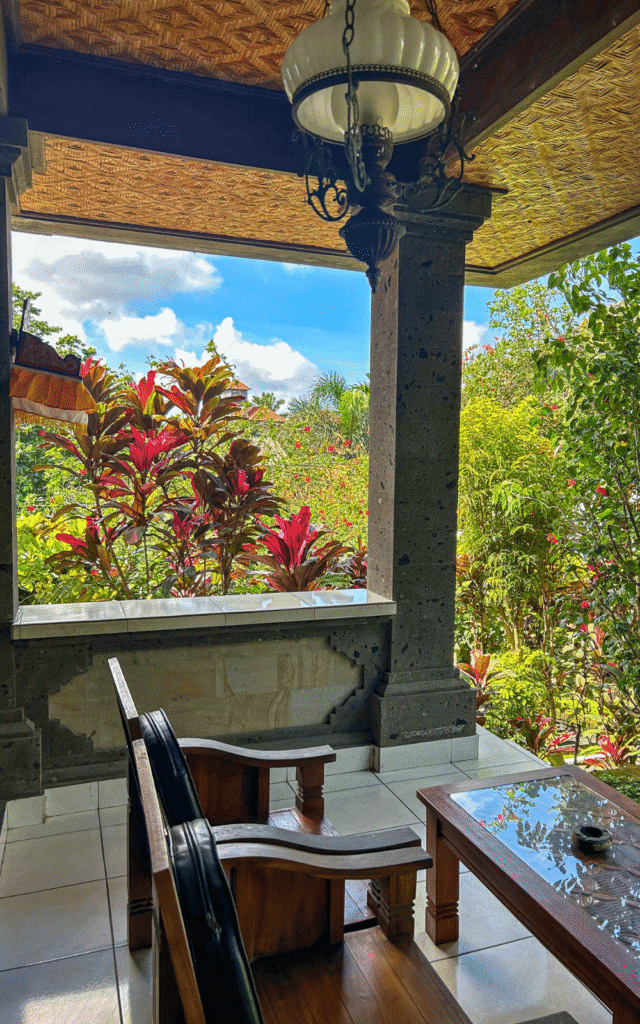
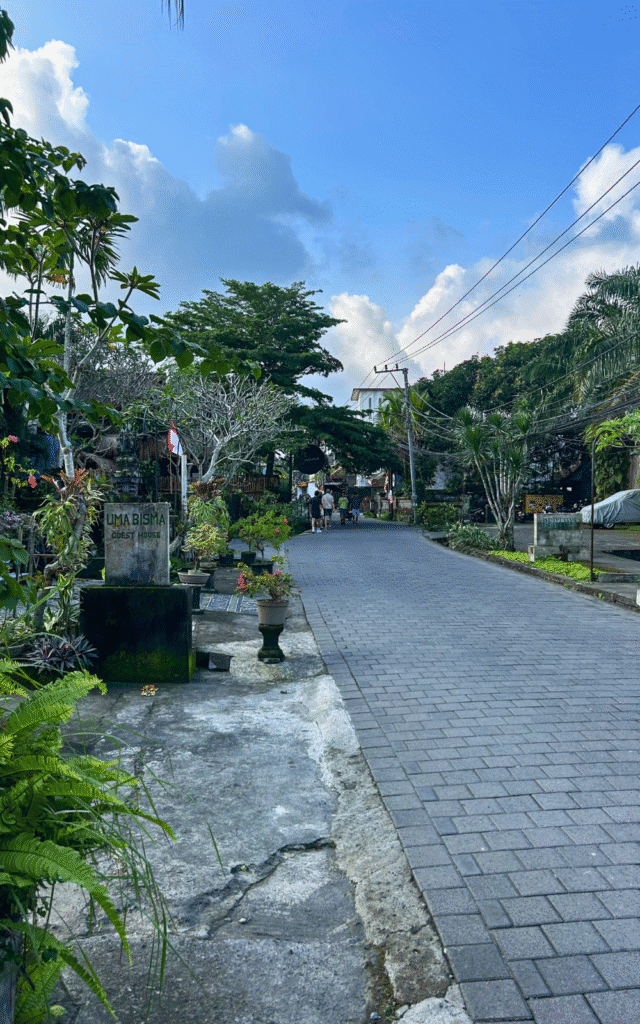
Jl. Bisma is a great fit if you plan to spend time walking through the rice field trails (Juwuk Manis or Sari Organik Walks) or heading to the Campuhan Ridge Walk. It’s just easier to access these places from there without having to cross busy roads every time.
Here are a couple of suggestions if you’re planning on staying in Jl. Bisma: where to stay, where to eat, and things to do around.
1. Where To Stay
Low-Budget Option: I lived at Bisma Jaya Bungalow for a couple of months, and it was the perfect stay for me. The rooms are simple, but the atmosphere is incredibly peaceful. The staff is so nice and the garden is beautifully maintained. There’s a lovely swimming pool overlooking the surrounding nature. Each bed comes with a mosquito net, which is definitely a plus in Bali — trust me, you’ll be grateful for it.
Mid-budget Option: Pertiwi Bisma Ubud is great if you’re looking to be surrounded by nature while still sleeping in modern and cozy rooms. The breakfast is amazing, and the hotel has two swimming pool areas to choose from. They can also arrange all kinds of activities for you — from tours to transport — so you don’t have to worry about a thing.
High-Budget Option: Bisma Eight is one of the most iconic boutique hotels in Ubud — you really can’t go wrong here. The hotel is absolutely stunning, with infinity pools offering 360° views of the jungle. It feels like a peaceful oasis, while still remaining close to the city center. Service is top-notch, and if you’re looking for an upscale and luxurious experience in Ubud, this is the place.
2. Favorite Restaurants on Jl. Bisma
Warung Gauri: One of my favorite warungs in Ubud — I keep coming back. The dining area is set in a small garden that feels like a home compound, with spiritual Indonesian music playing in the background and the scent of incense in the air. The food is delicious: they serve not only Indonesian specialties but also tasty rice bowls and even a seasonal avocado menu.
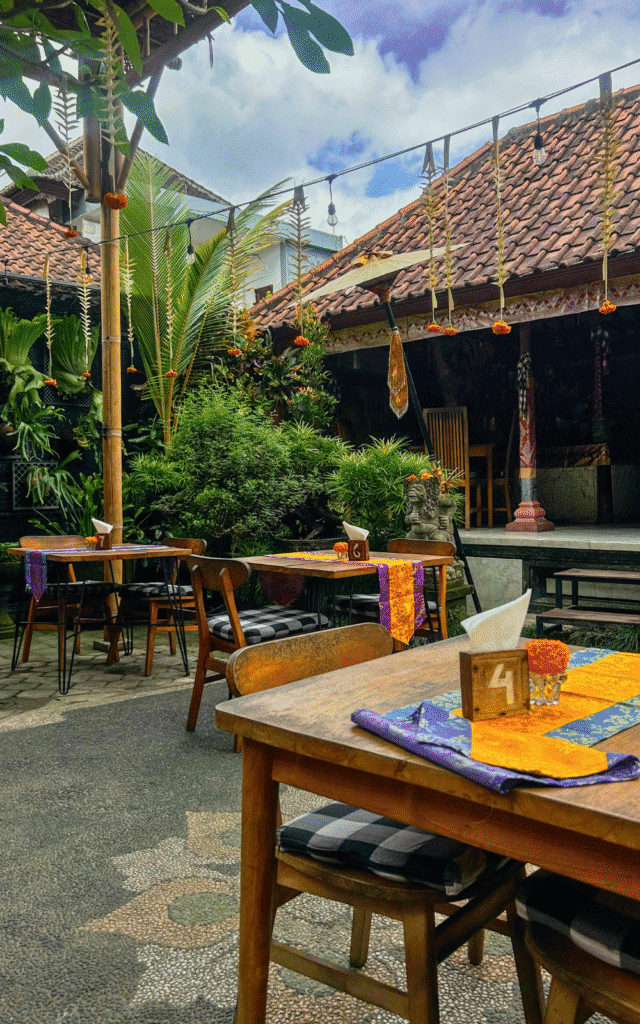
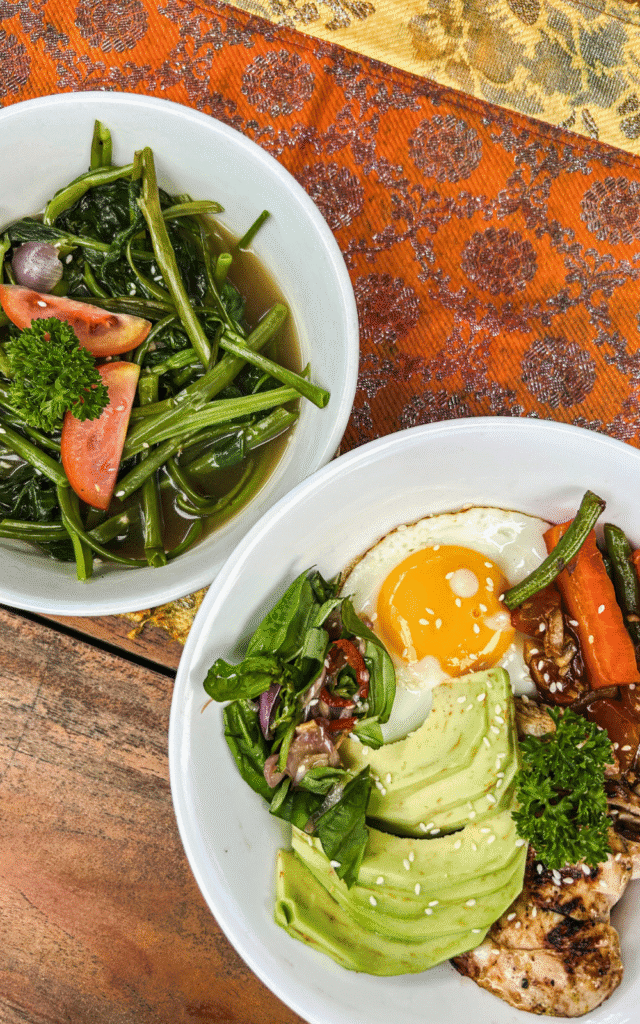
World Peace Soul Kitchen: I’ll admit it — the first time I read the menu, I wasn’t sure what to order. In the end, I went for the Indian dal (the yellow lentil one) with rice. Guys, the portion was huge, and I could barely finish it… But it was so good I had to finish it. The restaurant is an unusual mix of Indian and Italian food, which sounds random but somehow works. The garden — hidden from the road — is a super charming spot for dinner. Worth checking out.
A Few Cons (That Are Also Part of the Charm)
Because both streets are close to the center, they can get a little noisy. On Jl. Sukma, you might hear traffic coming from the main road, while on Jl. Bisma has some live music bars where the sound can carry in the evenings (but not until late)
But honestly, that’s also part of their charm—they’re both lively streets where it’s easy to meet other travelers, try a new restaurant every night, or enjoy an after-dinner walk surrounded by music, laughter, and people.
3. Things To Do Around
Here are a couple of activities you can plan if you’re staying around Jl. Bisma.
- Visit the Monkey Forest, just a couple of minutes from the end of Jl. Bisma (yep, that’s why we have monkeys wandering around!)
- Play a match at Bisma Padel, located toward the end of the road
- Get creative at Paint & Sip Ubud Art Workshop Studio – make your own candle or join an art class
2. Ubud Center: Rice Terrace Vibes
Yes—it’s totally possible to be surrounded by rice terraces and still stay just a five-minute walk from central Ubud.
If you’re looking for a stay immersed in nature but don’t want to be too far from town, you can look into the accommodations along the Sari Organik Walk and Juwuk Manis Walk (around Kajeng Rice Fields)
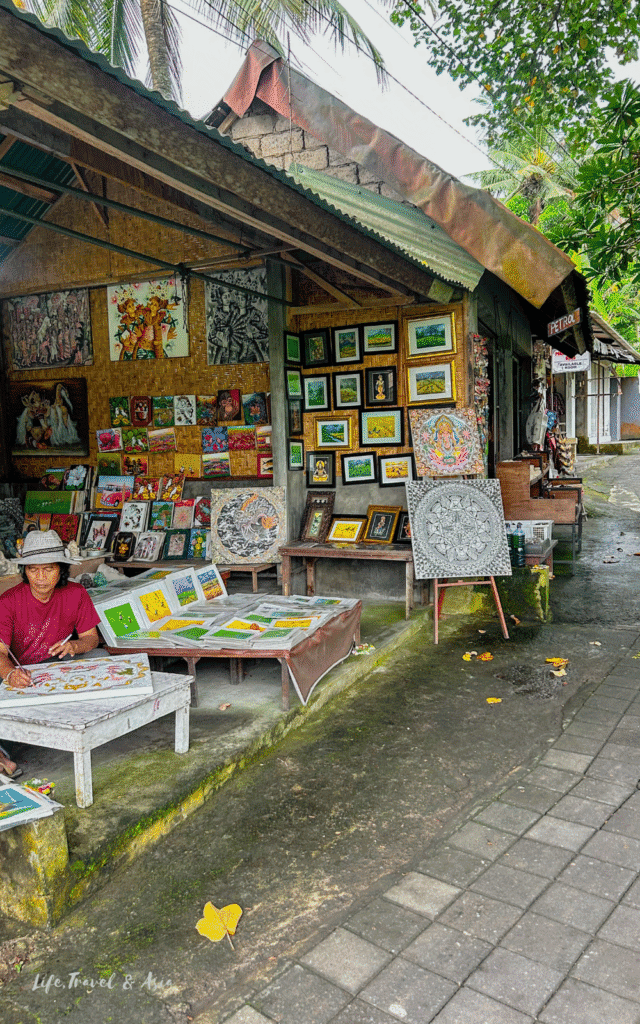
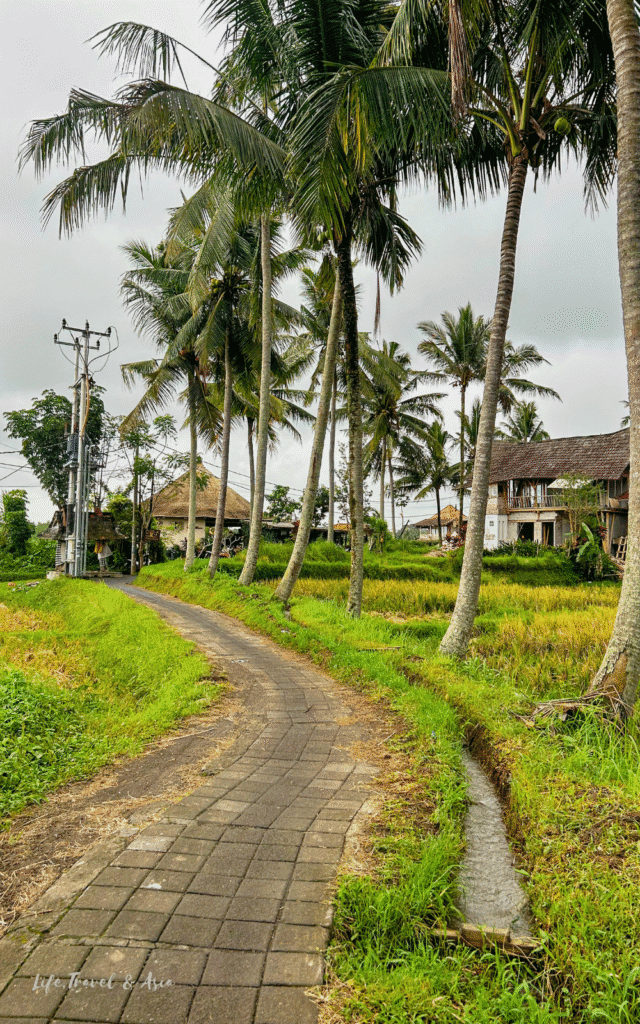
These are my go-to rice field walks whenever I need a reset and (above all) silence —and I always find myself admiring the charming guesthouses and pool villas along the paths.
One thing to keep in mind: cars can’t access these narrow paths—only scooters—so if you’re traveling with a suitcase rather than a backpack, be prepared to carry it on your way to the hotel.
Another downside is that street lighting in the area is minimal, so walking back at night after dinner in town might not be ideal unless you bring a flashlight or use your phone.
Sari Organik Walk: Cafes, Workshops & Rice Terrace Views
Along the Sari Organik Walk, you’ll find plenty of cozy cafés, art workshops (think silver jewelry or painting), yoga studios, retreat centers, and of course, a mix of guesthouses and villas surrounded by rice fields.
It’s the perfect place to stay if you’re attending a retreat at Ubud Yoga House, Yoga Union, or Body Mind Soul Bali — or if you want to be close to the city while still surrounded by peace, silence, and nature.
If you’re planning to stay along the Sari Organik Walk, here are some ideas on where to stay, eat, and what to do around the area.
1. Where To Stay
Low-Budget Option: Shankara Accommodation Ubud is a clean and quiet spot just 5 minutes from Jalan Raya — but it feels like miles away. Surrounded by rice fields, it offers on-site yoga classes and breakfast with dreamy jungle views.
Mid-budget Option: I pass by Nur Guest House every morning, and the relaxing vibe in this little corner of the Sari Organik Walk is unbeatable. The pool area is beautiful, and the rice fields all around make it the perfect morning view. Bonus? Every bed has mosquito net and the property is just steps away from Monkey Bar — one of my favorite cafés in Ubud.
High-Budget Option: Joglo Organik Guest House sits right at the end of the Sari Organik Walk, and the peace and quiet out there is simply unmatched. The property is stunning, with pools and private bungalows surrounded by the rice fields — but what really makes the difference is the staff, who always go the extra mile. It’s a bit farther than other options, but the experience is well worth the extra walk.
2. My Favorite Cafes on The Sari Organik Walk
If you’re booking your stay at Nur Guest House or Joglo Organik Guest House, you’ll be glad to know they’re just a short walk from some of my favorite cafes with rice terrace views in the area.
Monkey Bar: I always stop by for breakfast or lunch—this tiny café has one of the best views over the rice fields. Beyond the tasty food and affordable prices, it’s the atmosphere that keeps me coming back. It’s so peaceful, almost spiritual. You can sit in the beautifully decorated entrance or choose the quiet little garden nearby.
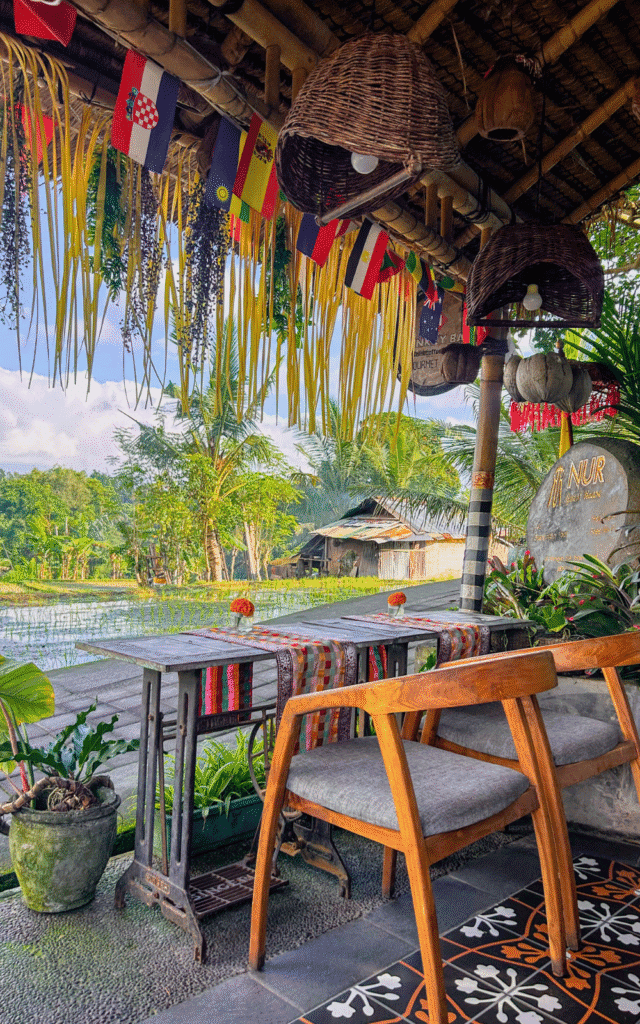
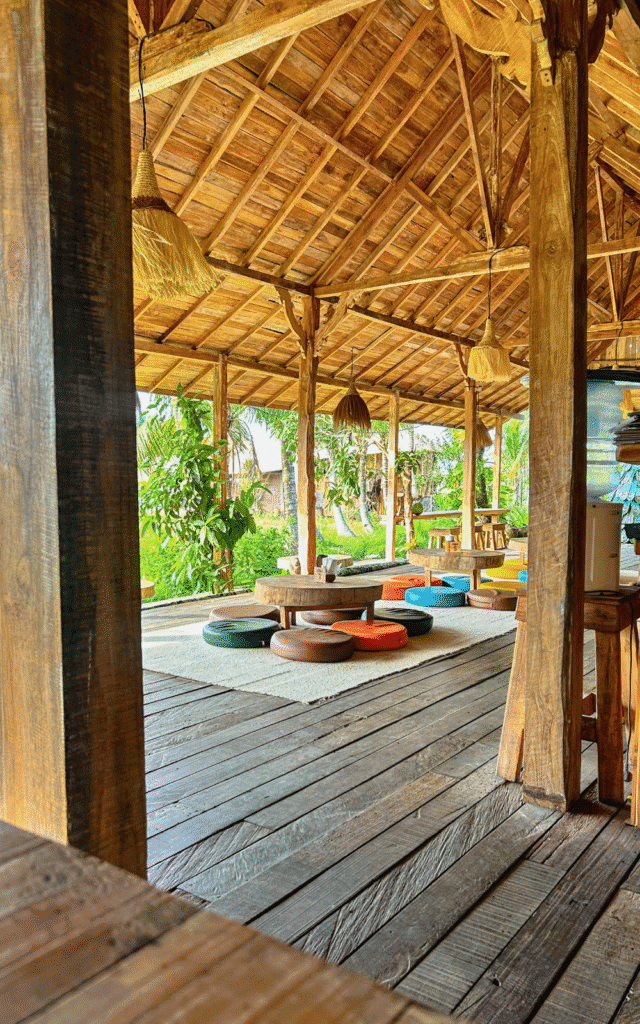
Joglo Organik: I always stop by for breakfast after my morning walk. Besides my go-tos—avocado toast and smoothie bowls—I keep coming back for the view and that peaceful feeling I crave in the morning.
3. Things To Do Around
Besides a chill walk through the rice fields or sipping a cappuccino with a view, here are a few things you might want to do in the area.
Sound Healing Session at Pyramids of Chi
If you’re into healing and meditation, a sound healing session feels almost like a rite of passage here in Ubud. I haven’t tried it myself (yet!), but everyone I’ve spoken to described it as deeply moving. One friend even told me she felt like her senses were sharper afterward.
Browse The Art Shops & Galleries
Around the Sari Organik Walk, you’ll stumble upon small art galleries, craft shops, and quirky handmade finds. It might just be the perfect spot to pick up a souvenir that feels a little more special and less expected.
Kajeng Rice Fields: Art Market, Rice Field Views & Luxury Villas
Usually, people differentiate between the Juwuk Manis Walk (also known as the Sweet Orange Trail) and the Kajeng Rice Fields, but they’re essentially the same trail—just with two different access points: one from Jalan Raya and one from Jalan Kajeng.
Jalan Kajeng is a narrow (and not-so-pedestrian) street, lined with local art and craft stalls on the left, and a mix of shops, warungs, and minimarkets on the right. If you follow the street all the way to the end, you’ll reach the start of the Juwuk Manis Walk, surrounded by peaceful rice fields.
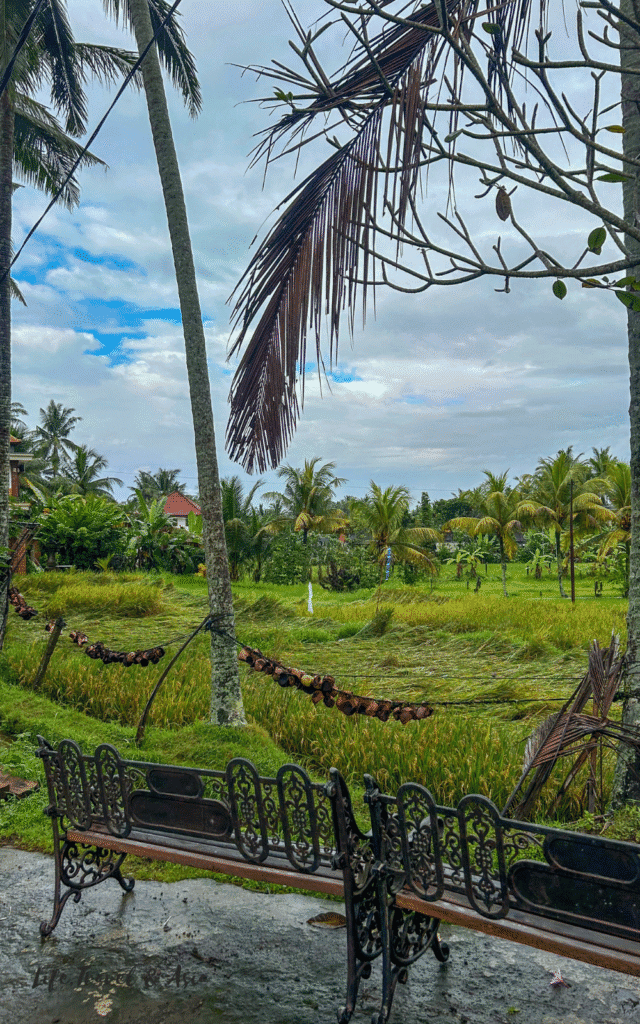
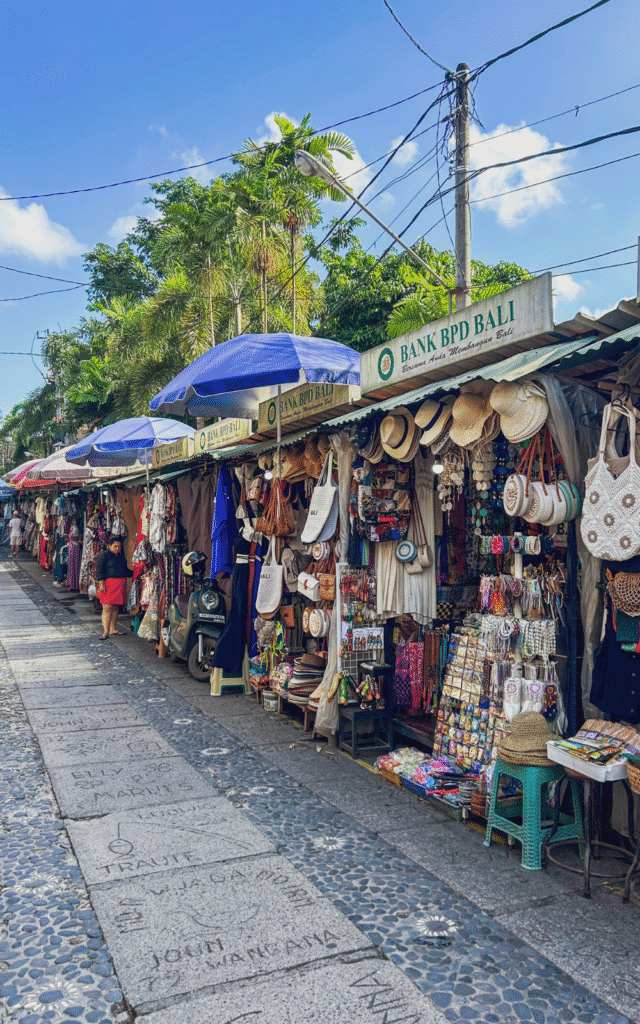
This part of the walk is a bit quieter compared to the Sari Organik, with fewer cafes, shops, and yoga studios—but it’s still well-loved by visitors for its stunning views and the sense of calm you can really feel here.
If you’re planning to stay along the Juwuk Manis Walk, here are a few ideas on where to stay, eat, and what to do in the area.
1. Where To Stay
Mid-budget Option: As I Am Ubud Retreat is the perfect spot if you’re looking to combine yoga (free for guests!) with surreal views over coconut trees and rice fields. The stay is super comfortable, the staff is lovely, the à la carte breakfast is delicious, and the peaceful location away from the busy center makes it even more special.
High-Budget Option: Prana Eco Wooden Villa is exactly what you’re looking for if you’re dreaming of a private, intimate, and magical stay in the Ubud rice fields. This newly built wooden villa offers total privacy, and the real highlight is the staff—super supportive and always ready to help when needed.
2. My Favorite Warungs on Sweet Orange Trail
Sweet Orange Warung: One of the warungs I keep coming back to—whether it’s for breakfast or lunch. The vibe is everything. In the morning it’s calm and peaceful, perfect for a smoothie bowl in front of the rice fields. By lunch, it’s buzzing with good energy, fellow travelers, and the smell of delicious food in the air.
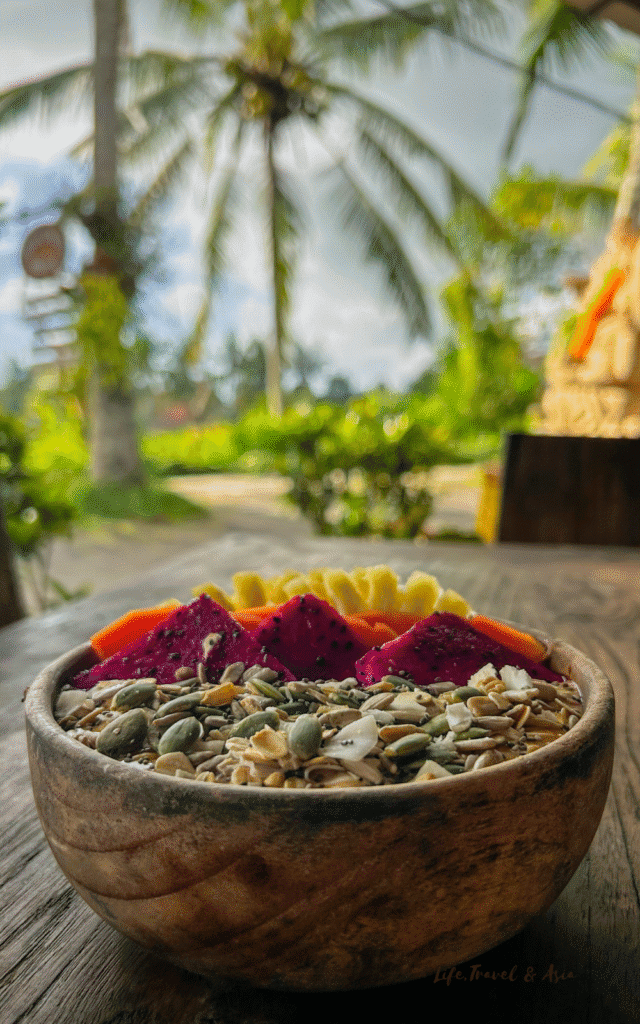
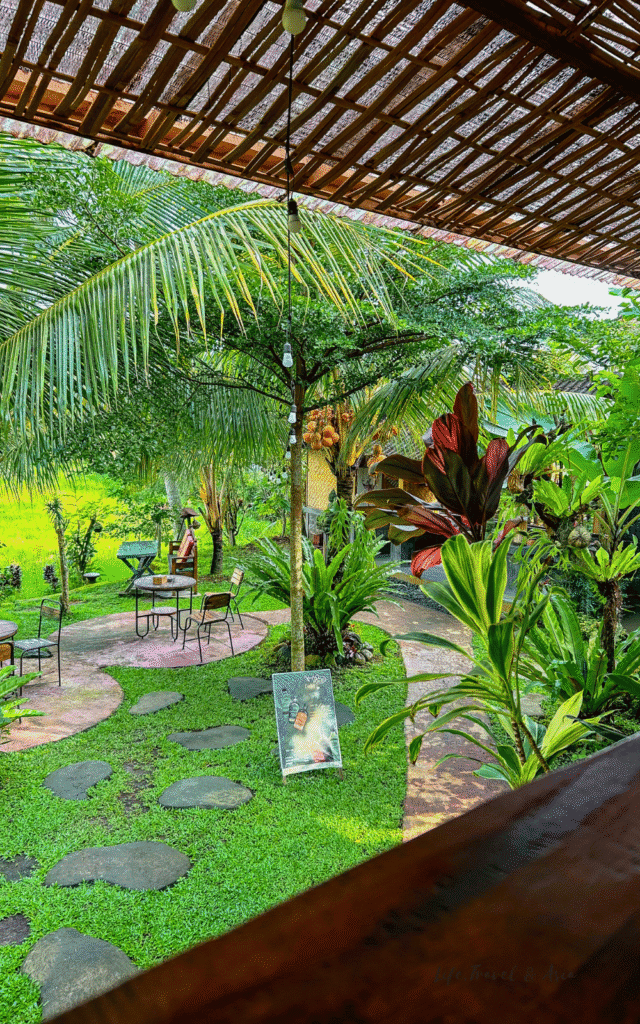
Aldi’s Coffee and Eatery: This is one of my go-to breakfast spots. I love having my morning bowl with a view over their tropical garden. It’s usually very quiet, especially in the morning—perfect for taking some time for yourself. Write, journal or even meditate.
3. Things To Do Around
Besides a morning walk surrounded by rice fields or sipping a coffee with a view, here are a few things you might want to do in the area.
Spa Treatments at Ubud Sari Health Resort
Located at the very end of Jl. Kajeng, this is one of the best value-for-money spas in Ubud. It’s a full wellness center offering retreats, yoga, and meditation—but also more affordable spa and beauty treatments. If you’re thinking of booking a massage or something more, check out my full review of the relaxing treatments I tried there.
Jl. Kajeng Market
Right before heading into the rice fields, take a moment to browse the Jl. Kajeng market—you might just find something special to bring back home. It’s usually way more peaceful than the busy Ubud market, so shopping here feels much more enjoyable.
3. Penestanan: Village-Vibe in Ubud
To me, Penestanan is the most magical area of Ubud. It’s the kind of place where you forget Ubud is a busy tourist town and instead feel a village-like, almost spiritual atmosphere.
Located just north of central Ubud, you reach Penestanan by walking down the tree-lined road past Pura Gunung Lebah, crossing the little Penestanan Bridge, and passing Zest. As you head uphill, you’ll notice the energy shifts—things get quieter, softer. This is where many expats and long-term travelers choose to live.
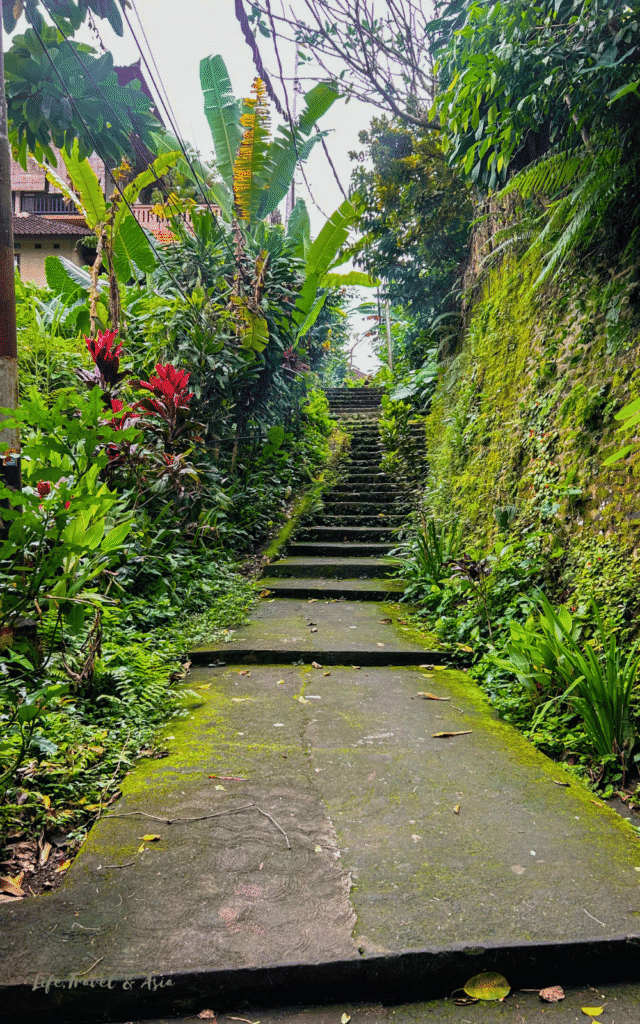
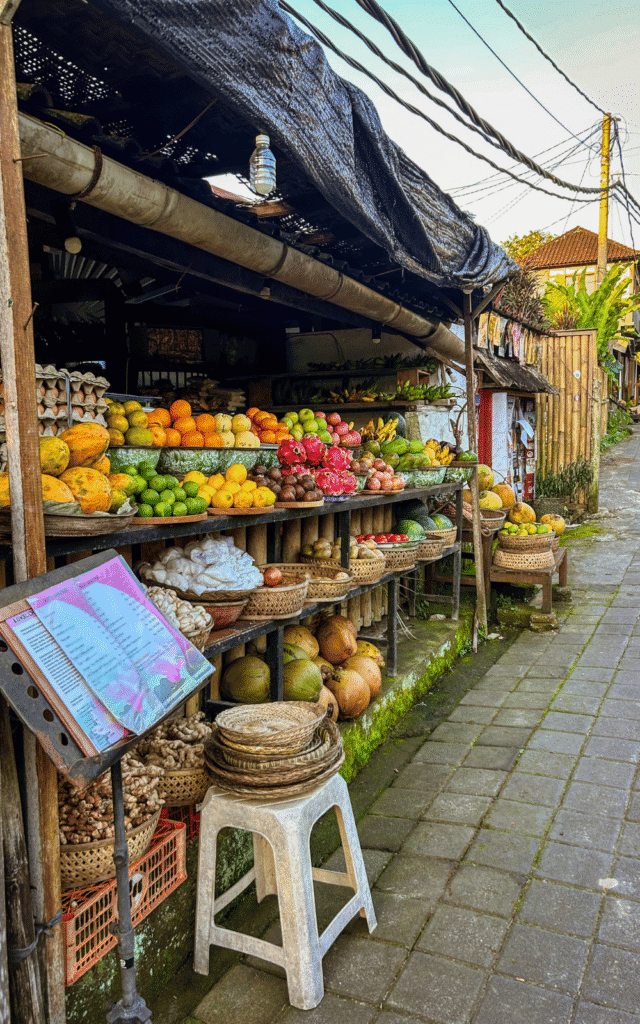
You’ll find plenty of guesthouses and pondok-style stays with jungle views, cute cafés to work from, peaceful rice fields, and some of the best yoga studios in town. Even if you’re staying in Ubud just for a few days, Penestanan is a beautiful option if you want something peaceful, local, and still not too far from the center.
1. Where to Stay in Penestanan
Low-budget Option: Rumah Ganesha Ubud feels like a little sanctuary tucked into nature, yet it’s still walking distance from Alchemy Yoga Studio and House of Om. The pool, the lush garden, and the delicious breakfast make it a perfect place to stay just outside the busiest parts of Ubud.
Mid-budget Option: Cahyatika Bed & Breakfast is a little gem in Penestanan, close to a small temple area. The rooms are very spacious with balcony and clean and the pool area is so lovely.
2. My Favorite Restaurants in Penestanan
Yellow Flower Cafe: One of the cutest cafés I’ve been to in Ubud. I highly recommend stopping by at least once for lunch. Between the almost spiritual atmosphere, the boho decor, and the rice field views, it’s a dreamy spot to unwind—and the food is chef’s kiss. Honestly, whatever you order, you can’t go wrong.
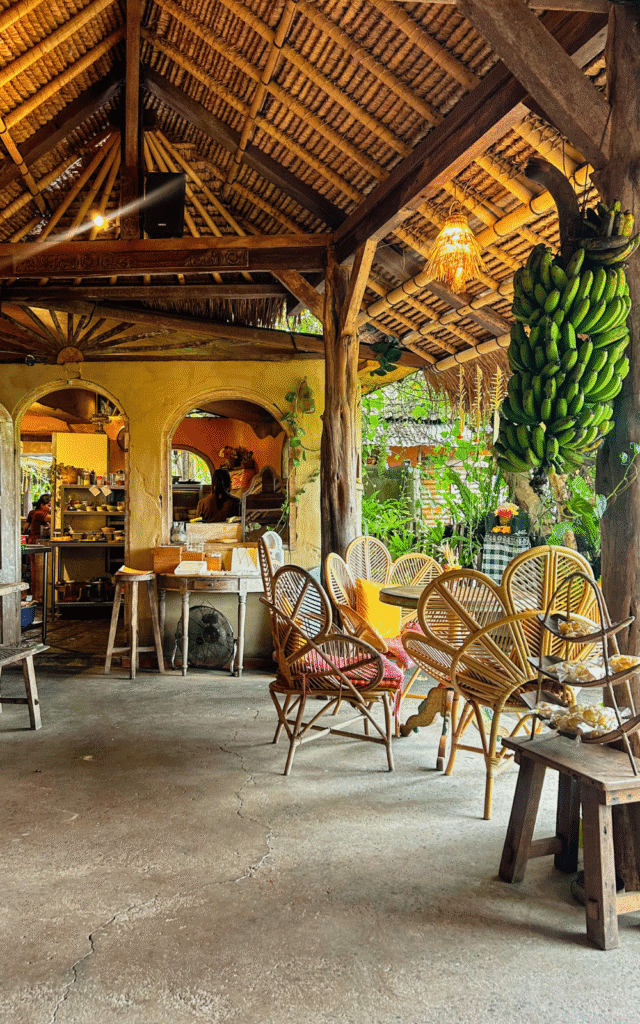
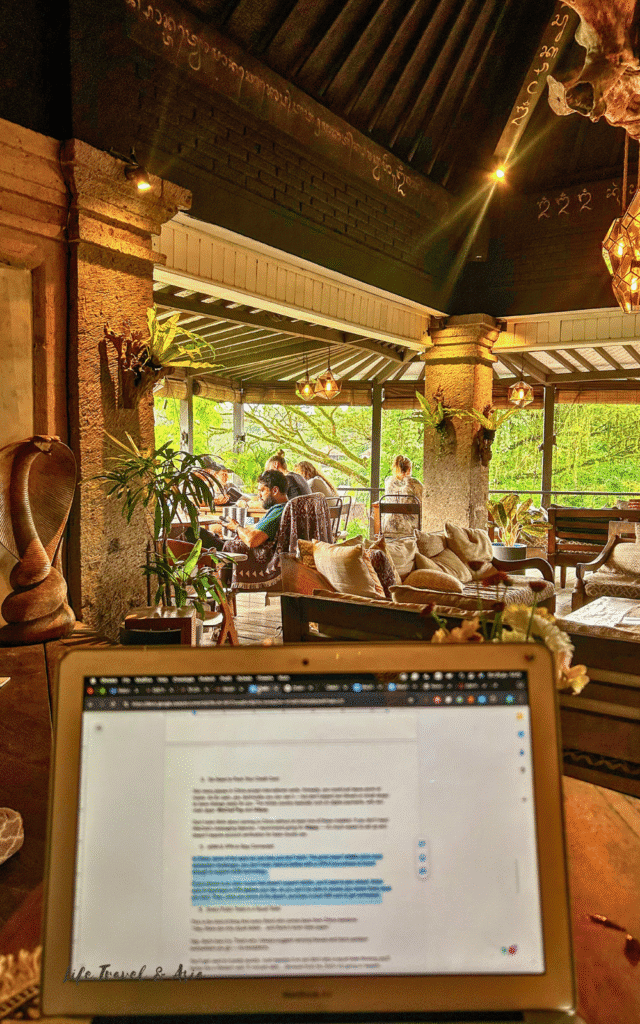
Zest: Zest is one of my favorite cafés to work from. Whether you’re vegan or not, their 100% plant-based menu will definitely win you over. Once again, it’s the creative, hippie atmosphere that draws so many expats and digital nomads here to get things done. Perched on a hill and surrounded by jungle, it truly feels like you’re eating up in a tree.
2. Things To Do Around Penestanan
Here are a couple of activities you can plan if you’re staying in the Penestanan area.
- Join a yoga class at Alchemy Studio or House of Om
- Explore your body through movement or ecstatic dance at Bara Dance Studio
- Take a peaceful walk around the Penestanan rice fields and soak in the views
4. Sayan & Kedewatan: Jungle, Luxury and Peaceful Vibes
If you’re dreaming of villas surrounded by the jungle, endless rice fields, epic sunsets, and real silence, Sayan and Kedewatan are where you’ll want to be.
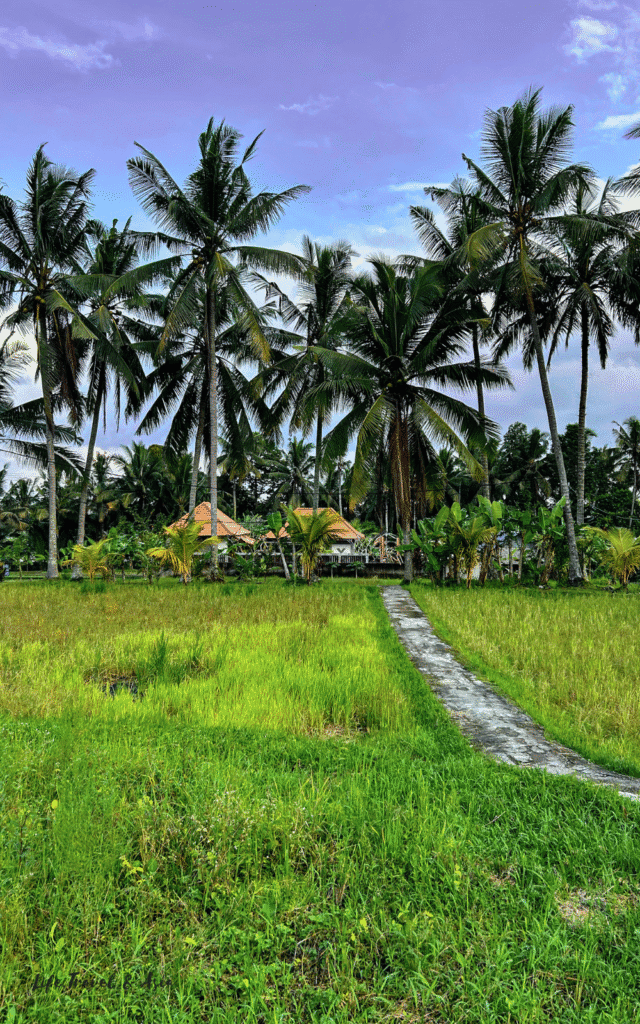
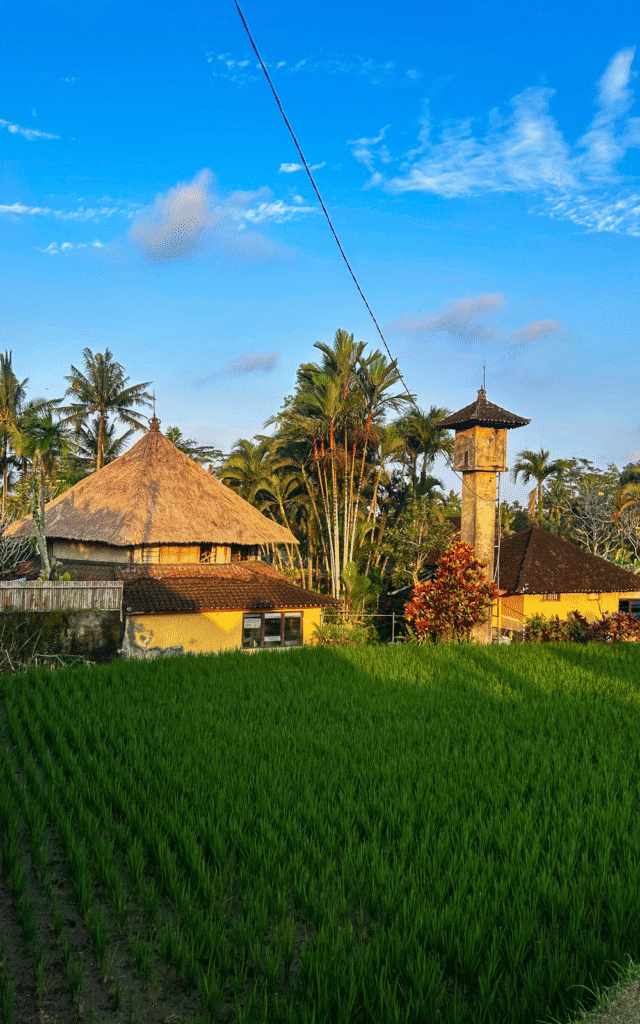
These areas are located in the Ayung River Valley, just a short drive from central Ubud. This is where you’ll find luxury resorts like the Four Seasons and Mandapa, a Ritz-Carlton Reserve, but also stunning private villas and boutique stays hidden in nature.
It’s my favorite area for long walks. Even just strolling through the quiet rice field lanes here feels like therapy—you’ll pass beautiful villas, rice fields, palm trees, and sometimes not a single other person.
Few Cons of Staying in This Area
Sayan and Kedewatan are farther from Ubud center—definitely not walkable. You’ll need a scooter or a driver to get around, and restaurants or shops are more spread out. But that’s kind of the point—this is the place to disconnect and slow down.
Where To Stay Around Sayan & Kedewatan
Low-Budget Option: Rana Suite is simple but has everything you need: a comfortable bed, a swimming pool, an outdoor kitchen, and even a TV. For such a low price, it’s definitely a hidden gem. The property is brand new and located in a peaceful, quiet area—perfect if you’re looking to escape the noise of central Ubud.
High-budget Option: Anumana De Suite is a stunning property nestled right in the middle of the jungle. From the spacious rooms and beautiful decor to the incredibly kind staff, everything here makes you feel like you’re living a truly luxurious and elevated experience. It’s the kind of place that feels both indulgent and deeply connected to nature.
Other Areas Around Ubud You Can Look Into
The areas mentioned above are great if you want to stay close to Ubud center. But if you’re looking for a more peaceful, authentic, village-style experience, there are a few other areas worth considering.
The pros: You’ll enjoy less traffic, fewer tourist crowds, and a quieter atmosphere without the constant calls from taxi drivers or offers for tours.
The cons: Being a bit more remote means restaurants and cafes are more spread out, activities are fewer, and you’ll find less of that social vibe that the center offers.
Still, if you’re looking for something more peaceful than the center, these areas might be exactly what you’re looking for:
1. Tegallalang
Tegallalang is a small village located north of Ubud, famous for its rice terraces—arguably the most photographed in Bali. And yes, you can actually stay right next to them!
I seriously considered basing myself here because accommodation is a lot more affordable compared to central Ubud, and many stays come with incredible rice field views.
The vibe here is slower and more traditional. Think vegetable markets lining the roads and dogs casually owning the streets.


Just a heads-up: you’ll need a scooter or hire a driver to get to Ubud town. It usually takes around 20–30 minutes, depending on traffic—which can get pretty heavy during the day as everyone heads to the rice fields.
Tegallalang may not be ideal if you’re traveling solo and hoping to meet lots of other travelers or go out at night. It’s more of a nature-and-rest zone than a social hotspot.
2. Nyuh Kuning – Quiet & Family-Friendly
Just south of the Monkey Forest, this peaceful village is full of flowers, wide walkways, and traditional homes. It’s perfect for families or anyone looking for calm energy and a safe, clean atmosphere—while still being close to the center.
3. Lodtunduh – Surrounded by Nature & Peace
Lodtunduh area is surrounded by rice paddies and artist studios, this area has a much slower pace than central Ubud, while still being close (25 minutes). You’ll need a scooter, but the peace and privacy are worth it.
4. Mas – Culture & Art
Mas is a village located about 6 km south of Ubud, known for its strong artistic heritage—especially woodcarving. It’s home to the Nyana & Tilem gallery, famous for masks and traditional wood sculptures.
If you’re planning to dive deep into Balinese art, culture, and craftsmanship, Mas is definitely worth considering. It’s quieter than Ubud center but still close enough to easily pop into town when you feel like it.
Wherever you choose to stay around Ubud, each area truly has its own charm—and yes, you can find a peaceful corner away from traffic, taxi drivers, and all the marketed offers.
No matter what you’re looking for, I hope this post helped you understand where to stay in Ubud depending on your interests, so you can plan a stay that actually matches your vibe and expectations.
✨ Want more tips on where to go, what to do, and how to move around? Check out my Ubud Travel Guide for all the information (and more) you may need before departure.
Which kind of atmosphere are you looking for? Quiet jungle mornings or lively streets full of energy? Let me know in the comments or feel free to drop your questions!
And hey—if you love getting real, honest travel tips about Bali and other corners of Asia (from someone who lives and travels here), make sure to subscribe to My Notes From The Road. That’s where I share the travel experiences and places that makes me feel alive, useful guides and inspiring travel stories from the road.
Get my Notes From The Road
Raw, unfiltered thoughts and travel experiences to inspire, guide, and remind you that every phase of life—especially the messy and chaotic ones—has something to teach us. Straight from my imperfect life in Asia.


